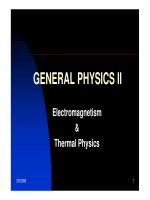- Trang chủ >>
- Khoa Học Tự Nhiên >>
- Vật lý
Tài liệu Chapter XIV Kinetic-molecular theory of gases – Distribution function doc
Bạn đang xem bản rút gọn của tài liệu. Xem và tải ngay bản đầy đủ của tài liệu tại đây (1.63 MB, 37 trang )
4/22/2008 1
GENERAL PHYSICS II
Electromagnetism
&
Thermal Physics
4/22/2008 2
Chapter XIV
Kinetic-molecular theory of gases –
Distribution functions
§1. Kinetic–molecular model of an ideal gas
§2. Distribution functions for molecules
§3. Internal energy and heat capacity of ideal gases
§4. State equation for real gases
4/22/2008 3
From this Chapter we will study thermal properties of matter, that is
what means the terms “hot” or “cold”, what is the difference between
“heat” and “temparature”, and the laws relative to these concepts.
We will know that the thermal phenomena are determined by internal
motions of molecules inside a matter. There exists a form of energy
which is called thermal energy, or “heat”, which is the total energy of
all molecular motions, or internal energy.
To find thermal laws one must connect the properties of molecular
motions (microscopic properties) with the macroscopic thermal
properties of matter (temperature, pressure,…). First we consider an
modelization of gas: “ideal gas”.
4/22/2008 4
§1. Kinetic–molecular model of an ideal gas:
1.1 Equations of state of an ideal gas:
Conditions in which an amount of matter exists are descrbied by the
following variables:
Pressure ( p )
Volume ( V )
Temperature ( T )
Amount of substance ( m or number of moles n, m = n.M)
These variables are called state variables
molar mass
There exist relationships between these variables. By experiment
measurements one could find these relationship.
4/22/2008 5
Relationship between p and V at a constant
temperarure:
The perssure of the gas is given by
where F is the force applied to the
piston.
By varying the force one can
determine how the volume of the
gas varies with the pressure.
Experiment showed that
where C is a constant
This relation is known as
Boyle’s or Mariotte’s law
4/22/2008 6
Relationship between p and T while a
fixed amount of gas is confined to a closed
container which has rigid wall (that means V
is fixed).
Experiment showed that with a appropriate
temperature scale the pressure p is
proportional to T, and we can write
where A is a constant.
This relation is applicable for temperatures in
ºK (Kelvin). Temperatures in this units are
called absolute temperature.
The instrument shown in the picture can use as a type of thermometer
called constant volume gas thermometer.
4/22/2008 7
Relationship between the volume V and mass or the number of moles n:
Keeping pressure and temperature constant, the volume V is proportional
to the number of moles n.
Combining three mentioned relationships, one has a single equation :
This equation is called “equation of state of an ideal gas ”.
• The constant R has the same value for all gases at sufficiently high
temperature and low pressure → it called the gas constant (or ideal-gas
constant).
In SI units: p in Pa (1Pa = 1 N/m
2
); V in m
3
→ R = 8.314 J/mol.ºK.
• We can expess the equation in terms of mass of gas: m
tot
= n.M
pV RT
n
pressure volume
# moles
gas constant
temperature
pV
RT
M
m
pV
tot
4/22/2008 8
1.2 Kinetic-molecular model of an ideal gas:
a “microscopic model of gas”:
Gas is a collection of molecules or atoms which
move around without touching much each other
Molecular velocities are random (every direction
equally likely) but there is a distribution of speeds
GOAL: to relate state variables (temperature, pressure)
to molecular motions. In other words, we want construct
From the microscopic view point we have the IDEAL Gas definition:
molecules occupy only a small fraction of the volume
molecules interact so little that the energy is just the sum of the
separate energies of the molecules (i.e. no potential energy from
interactions)
Examples: The atmosphere is nearly ideal, but a gas under high
pressures and low temperatures (near liquidized state) is
far from ideal.
4/22/2008 9
For a single collision:
(the x-component changes sign)
A
F
p
v
m v
x
x x
x
p (mv )
F
t t
x
x
mvp 2
t
mv
F
x
x
2
Pressure is the outward force per unit area
exerted by the gas on any wall :
The force on a wall from gas is the time-averaged momentum
transfer due to collisions of the molecules off the walls:
If the time between such collisions = dt, then the average force on
the wall due to this particle is:
t
F
x
<F
x
>
means
"time average"
One of the keys of the kinetic-molecular model is to relate pressure
to collisions of molecules with any wall:
4/22/2008 10
Assume we have a very sparse gas (no molecule-molecule collisions!):
x
v
d
t
2
Pressure from molecular collisions proportional
to the average translational kinetic energy of molecules:
d
mv
vd
mv
t
mv
F
x
x
xx
x
2
)/2(
22
2
xx
v
d
Nm
F
22
xx
x
v
V
Nm
v
Ad
Nm
A
F
p
Average force:
(one molecule)
Net average force:
(N molecules)
PRESSURE:
We can relate this to the average translational kinetic energy of each
molecule:
Time between collisions with wall:
round-trip time (depends on speed)
d
v
x
Area A
average"time"
means
2
2
22
2
3
2
1
xzyxtr
vmvvvmk
tr
k
V
N
p
3
2
macroscopic variable
microscopic
property
4/22/2008 11
N
A
= Avogadro’s number = 6.02 x 10
23
molecules/mole
mass of 1 mole in gam = molecular weight (e.g, O
2
:32g; H
2
:2g)
Consider 1 mole of gas:
1 mole = the amount of gas which consists the number N
A
of molecules
• Applying the equation for pressure to 1 mole of gas we have
mole
trtrA
KkNpV
3
2
3
2
mole
tr
K
where
is the total translational
kinetic energy of 1 mole
Compare this with the ideal gas equation (for 1 mole, n=1):
RT
pV
RTK
mole
tr
2
3
for n moles of gas→
nRTK
tr
2
3
We have arrived to a simple, but important result:
The average total translational kinetic energy of gas
is proportional to the absolute temperature
4/22/2008 12
kT
T
N
R
N
K
k
AA
mole
tr
tr
2
3
2
3
A
N
R
k
For a single molecule the translational kinetic energy is
where we have denoted
The constant k occures frequently in molecular physics. It is called the
Boltzmann constant. It’s value is
KJ
mol
KmolJ
k
023
23
0
/10381.1
/10022.6
./314.8
kTk
tr
2
3
So, the average translational kinetic energy of a single molecule is
which depends only on absolute temperature.
The temperature can be considered as
the measure of random motion of molecules
4/22/2008 13
§2. Distribution functions for molecules:
In the view point of a microscopic theory an amount of ideal gas is
an ensemble of molecules, in which
• The number of molecules is very large
• Every molecule has an independent motion
So, what we can know about them:
• The average properties: average kinetic energy, average speed,…
• Distribution of molecules according to any properties, for example:
• How many per cent, or probability of molecules having the speed v ?
• Probability of molecules at a height z in a gravitational field?
Distribution of molecules is given by distribution functions.
We will consider two such distribution functions:
• Distribution on the height (or potential energy) in a gravitational field
• Distribution on the speed (or kinetic energy) of molecules
4/22/2008 14
2.1 Distribution of molecules in a gravitational field:
• Consider an ideal gas in a uniform
gravitational fields, for example in the
earth’s gravity.
• Assume that the temperature T is the
same everywhere.
The equation of state
gives the pressure as a function of height z :
the number of molecules
in unit volume
the molecular mass
the density of the
gas at the height z
4/22/2008 15
n at z = 0
•The difference in pressure between z and z + dz is given by
For the pressure
or
This formula is called
“the law of atmospheres”
This is the distribution
function on gravitational
potential energy of molecules
4/22/2008 16
2.2 Distribution of molecular speeds in an ideal gas:
• Boltzmann pointed out that the decrease in
molecular density with height in a uniform
gravitational field can be understood in terms of
the distribution of the velocities of molecules
at lower levels in the gas:
• Molecules leaving the level z = 0 with the
velocities less than v
z
in the equation
will fail to reach the height z.
Similarly,
The number of molecules
per unit volume which have
the z-component of velocity
between v
z
and v
z
+ Δv
z
The difference Δn between the
number per unit volume at
height z and that at height z+Δz
=
4/22/2008 17
Differentiating the distribution function with respect to z we obtain
Since the number of molecules per unit volume at
temperature T with z-component of velocity must be proportional with
the factor
Boltzmann reasoned that this proportional relation should be the same
where or not the gas is in a gravitational field, and therefore we can write
where A is a constant, P
z
(v
z
) is the
probability per unit interval of v
z
.
The constant A is determined from the condition
Making the replacement and applying
the formula
4/22/2008 18
The fraction of molecules with z-component of velocity between v
z
and
v
z
+ Δv
z
is given by
Similarly we have for the distribution
functions for v
x
and v
y
:
We now can write the expression for the fraction of molecules in an ideal
gas at temperature T with x-component of velocity lying in the interval
v
x
→ v
x
+ Δv
x
; y-component of velocity lying in the interval v
y
→ v
y
+ Δv
y
;
z-component of velocity lying in the interval v
z
→ v
z
+ Δv
z
4/22/2008 19
The function
is known as the Maxwell-Boltzmann
velocity distribution function.
In a velocity diagram, the velocity of
a single molecule is represented by
a point having coordinates (v
x
, v
y
, v
z
)
The number of molecules having velocities
in the “volume” element is
(N: the total number of molecules
of the whole system)
The number of molecules with speeds between v and v + Δv is the
number of loints in the sperical shell between the radius v and v +Δv:
4/22/2008 20
Deviding by N we have the fraction of molecules in a gas at temperature T
with speeds between v and v + Δv :
The function P(v) =
gives the Maxwell-Boltzmann distribution function of molecular speeds.
Remark that the Maxwell-Boltzmann distribution function depends
on temperature. This dependence is shown in the picture.
4/22/2008 21
T
2
> T > T
1
At higher temperature the distribution curve is flatter,
and the maximum of the curve shifts to higher speed.
4/22/2008 22
2.3 Average speeds of molecules:
Using the distribution function of molecular speeds one can calculate
average values of molecular speeds. There are three types of average
values:
2.3.1 The average speed of the molecules < v >:
• Definition:
• Result:
0
)( dvvvPv
The auxilary integral:
m
kT
v
8
4/22/2008 23
2.3.2 The root-mean-square (rms) speed:
First we take the average value of the square of the speed:
and hence the rms speed is given by
which is, obviously, not the same as the value of the average speed.
The auxilary integral:
4/22/2008 24
2.3.3 The most probable speed v
m
:
This is the speed which corresponds to the maximum of the speed
distribution curve, that is
when is maximum
The two solution v = 0 and v = ∞correspond to minima, hence the third
solution must correspond to the maximum, so we have
The relative magnitudes of < v >, v
rms
and v
m
at temperature T are
indicated on the figure.
4/22/2008 25
§3. Internal energy and heat capacity of ideal gases:
We have had before the result:
Molecules in their motion have a kinetic energy
The molecular kinetic energy is proportional to
the absolute temperature
What is the energy of an amount of gas ?
kTk
tr
2
3
Now we consider an ideal gas in aspects of energy
3.1 Internal energy of ideal gas:
The kinetic-molecular model states that
The internal energy of an ideal gas is of the sum of the kinetic energies
of all molecules
For a single molecule the kinetic energy consists of two parts: the
translational and rotational









